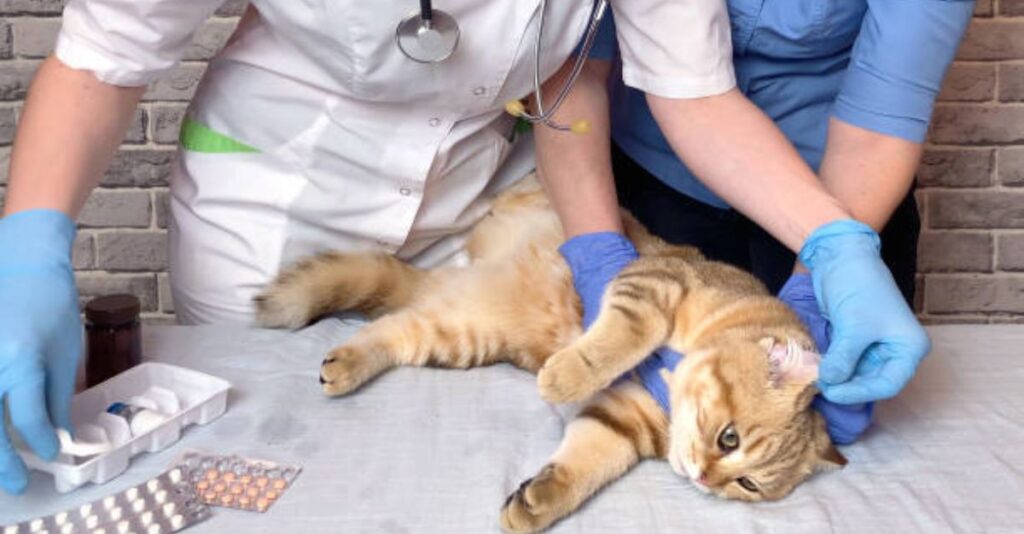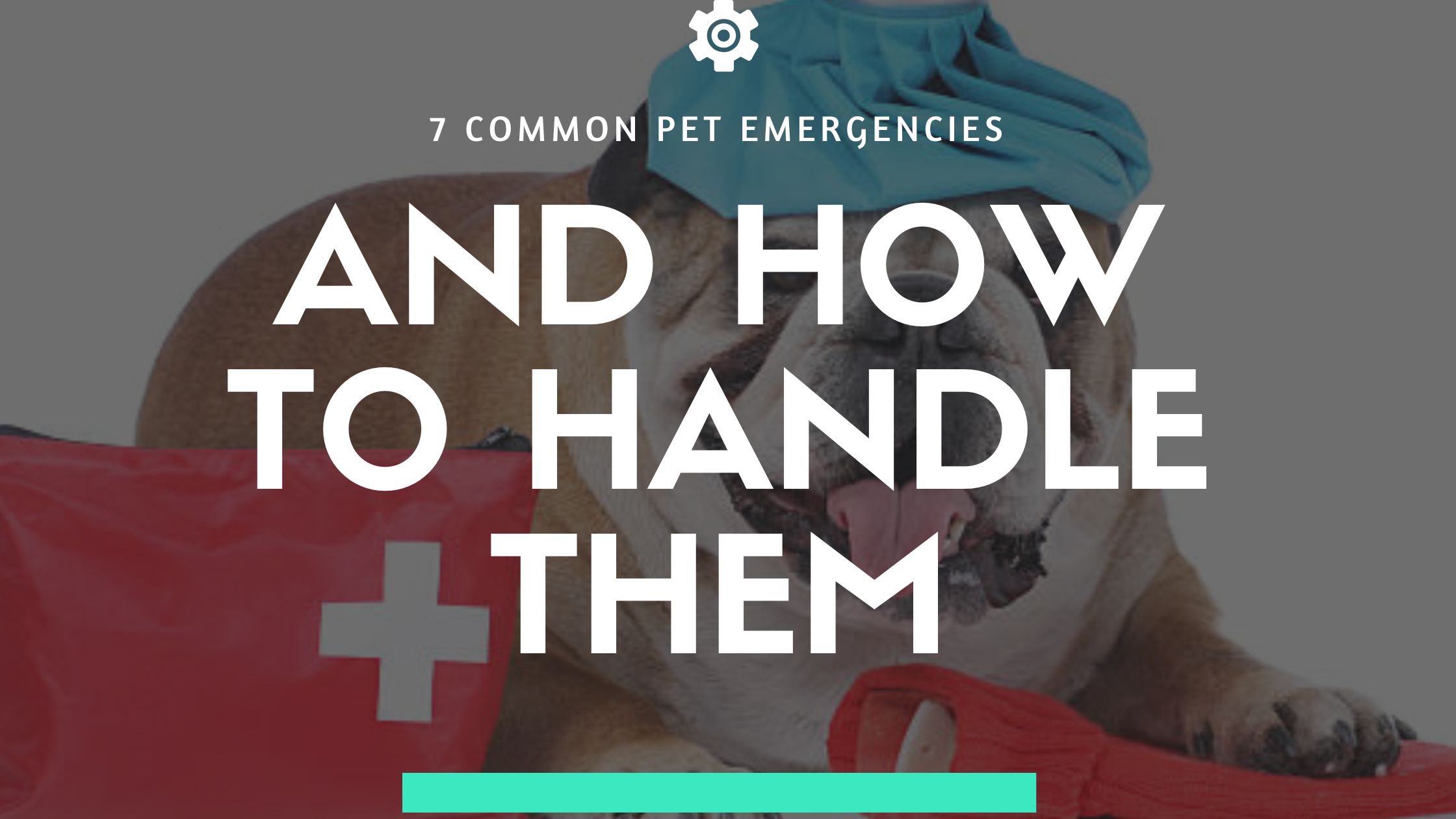Introduction
7 Common Pet Emergencies and How to Handle Them
Pets are beloved members of our families, and their health and safety are of utmost importance. Accidents and emergencies can happen at any time, making it crucial for pet owners to know basic first aid techniques. This guide provides essential information on emergency care and first aid for pets to help you act swiftly and effectively during critical situations.
7 Common Pet Emergencies and How to Handle Them

1. Choking
Signs: Pawing at the mouth, difficulty breathing, excessive drooling, coughing, or blue gums. What to Do:
- Open the pet’s mouth carefully and look for any visible objects.
- If visible, try to remove it with tweezers or your fingers (avoid pushing it further).
- If the pet is unconscious, perform the Heimlich maneuver by applying firm, quick pressure to the abdomen.
- Seek immediate veterinary care.
2. Poisoning
Signs: Vomiting, diarrhea, drooling, seizures, lethargy, or difficulty breathing. What to Do:
- Identify the toxin and call a veterinarian or pet poison hotline immediately.
- Do not induce vomiting unless advised by a professional.
- Keep any packaging or samples of the substance for identification.
- Seek urgent veterinary attention.
3. Seizures
Signs: Uncontrollable shaking, loss of consciousness, drooling, or stiff limbs. What to Do:
- Keep the pet away from hard objects to prevent injury.
- Do not try to restrain them; let the seizure run its course.
- Time the seizure duration—if it lasts more than five minutes, seek emergency help.
- Afterward, keep the pet calm and contact your vet.
4. Heatstroke
Signs: Excessive panting, drooling, red gums, vomiting, and collapse. What to Do:
- Move the pet to a cool area and offer small sips of water.
- Use cool (not cold) water on the paws, ears, and body.
- Use a fan or air conditioning to lower the temperature.
- Seek immediate veterinary care.
5. Broken Bones
Signs: Limping, swelling, visible fractures, or unwillingness to move. What to Do:
- Keep the pet still and minimize movement.
- Do not attempt to realign the bone.
- Use a makeshift splint if necessary, but avoid causing more pain.
- Transport the pet carefully to the veterinarian.
6. Severe Bleeding
Signs: Continuous bleeding, deep wounds, weakness, or pale gums. What to Do:
- Apply direct pressure with a clean cloth or bandage.
- Elevate the injured area if possible.
- Apply a cold compress to slow the bleeding.
- Seek immediate veterinary care.
7. Bloat (Gastric Dilatation-Volvulus)
Signs: Swollen abdomen, restlessness, drooling, unproductive retching, or rapid breathing. What to Do:
- Do not try to induce vomiting.
- Keep the pet as calm as possible.
- Transport the pet to the veterinarian immediately as this is a life-threatening condition.
When to Seek Emergency Veterinary Care
Pet owners should seek immediate emergency care if their pet exhibits any of the following symptoms:

- Difficulty breathing or choking
- Continuous vomiting or diarrhea, especially with blood
- Seizures lasting more than five minutes or multiple seizures in a row
- Unconsciousness or unresponsiveness
- Severe bleeding that does not stop within five minutes
- Inability to stand, walk, or sudden paralysis
- Signs of extreme pain, including excessive whining, panting, or aggression
- Ingestion of toxic substances, such as chocolate, antifreeze, or household chemicals
- Bloat symptoms, including a distended abdomen and unsuccessful attempts to vomit
If you are ever in doubt, contact your veterinarian or an emergency pet clinic immediately. Quick action can save your pet’s life.
Tips for Preventing Pet Emergencies
Preventing pet emergencies involves proactive care, awareness, and preparation. Here are some essential tips to keep your furry friends safe and healthy:

1. Provide Proper Nutrition
- Feed your pet a balanced diet appropriate for their species, age, and health condition.
- Avoid feeding human foods that can be toxic, such as chocolate, grapes, onions, and xylitol.
2. Keep Hazardous Items Out of Reach
- Store household cleaners, medications, and toxic plants out of pets’ reach.
- Secure trash cans to prevent pets from ingesting harmful items.
3. Maintain Regular Vet Visits
- Schedule annual checkups and vaccinations to catch health issues early.
- Keep up with flea, tick, and heartworm prevention.
4. Pet-Proof Your Home
- Keep electrical cords, sharp objects, and small items that could be swallowed away from pets.
- Check for choking hazards, such as small toys and bones.
5. Supervise Outdoor Activities
- Keep pets on a leash or in a secure area to prevent accidents, fights, or exposure to toxins.
- Avoid letting pets roam freely, especially near roads or wild animals.
6. Monitor Signs of Illness or Injury
- Watch for unusual behavior, vomiting, lethargy, or difficulty breathing.
- Seek veterinary care immediately if you notice any concerning symptoms.
7. Prevent Heatstroke & Cold-Related Illnesses
- Never leave pets in a hot car, even for a few minutes.
- Provide shelter and warmth during cold weather.
8. Train and Socialize Your Pet
- Teach basic commands like “stay” and “come” to prevent accidents.
- Socialize pets to reduce fear-based aggression and anxiety.
9. Be Prepared for Emergencies
- Have a pet first-aid kit with bandages, antiseptic wipes, and emergency contacts.
- Know the location of the nearest emergency vet clinic.
10. Spay and Neuter Your Pet
- Helps prevent certain health issues and unwanted pregnancies.
- Reduces the risk of roaming, fights, and infections.
By taking these preventive measures, you can minimize the chances of pet emergencies and ensure a long, healthy life for your beloved companion. Would you like this expanded into a blog post for your website?
Conclusion
Being prepared for pet emergencies can save lives. Keep a first aid kit ready, familiarize yourself with basic emergency procedures, and always seek professional veterinary care when needed. Your quick response and knowledge can ensure your furry friend gets the best care possible during a crisis.
By following these emergency care and first aid tips, you can be a responsible pet owner and protect your pet’s health and well-being. Always remember to stay calm and act swiftly in any emergency situation!
References
- American Veterinary Medical Association (AVMA)
- Pet Poison Helpline
- ASPCA Animal Poison Control Center
- Veterinary Emergency and Critical Care Society (VECCS)
FAQs
1. How do I know if my pet needs emergency care?
If your pet is experiencing severe symptoms like difficulty breathing, unconsciousness, excessive bleeding, or seizures, seek emergency veterinary care immediately.
2. What should I include in a pet first-aid kit?
Essential items include gauze, antiseptic wipes, tweezers, a digital thermometer, pet-safe pain relief, and emergency vet contact information.
3. Can I give my pet human medication in an emergency?
No. Many human medications are toxic to pets. Always consult a veterinarian before giving any medication.
4. How can I prevent my pet from choking?
Avoid giving small objects, bones, or toys that can be swallowed easily. Supervise meals and playtime.
5. What is the best way to transport an injured pet?
Use a blanket or sturdy board to keep them stable. Keep movements minimal to prevent further injury, and go directly to a veterinarian.
Staying informed and prepared can help protect your pet in emergencies. Always seek professional veterinary help when in doubt.

